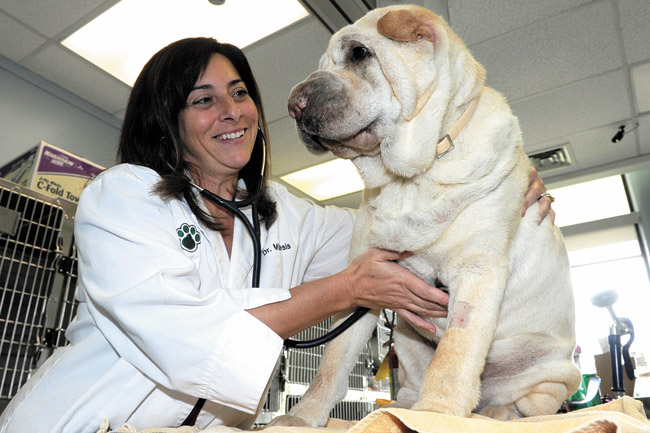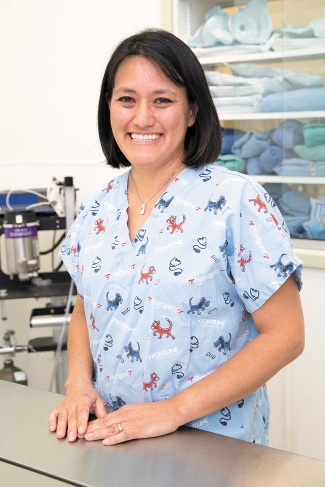Amazing Results For Stem Cell Therapy In Pets
The procedure is minimally invasive and has been shown to work for animals with stiff joints and kidney problems, among others ailments
Tenuous as it begins and full of moments of terror, the unaffected and unabashed relationship that develops between animals and humans is why so many people are pet owners.
As pets age, and even sometimes at earlier stages in life, health issues related to joints may surface. For some, it becomes a debilitating problem.
In the past, the solution meant orthopedic surgery requiring restful recuperation – a task that becomes more difficult with no way to communicate to animals what is required of them. It also might mean regular use of medication.
Now, pet owners can turn to minimally invasive stem cell therapy.
“Around the world, we’ve probably treated about 10,000 animals, and nobody has gotten sick,” says MediVet Hawaii owner Carole Spangler Vaughn.
Part of a global company, MediVet supplies the technology and means necessary for veterinary clinics to complete stem cell procedures. Vaughn began the Hawaii leg of the corporation about a year and a half ago.
The therapy requires animals to be under anesthesia only for approximately 30 minutes, versus a surgical procedure that could take longer. This is especially beneficial for geriatric patients, whose risk for undergoing lengthy periods of anesthesia may be higher.
The next step only requires an incision in the shoulder blade or abdomen, where fat is extracted to be harvested. The use of an animal’s own fat also is what makes the procedure safe.
After waking from anesthesia, animals spend the rest of the day hanging out with veterinary staff. During the next four to five hours, fat is processed and stem cells are isolated through various enzymatic procedures. It is a process that Vaughn likens to waking the stem cells to prepare them to work in the body. Owners also have the option to bank stem cells for future use.
Purified stem cells are available at the end of the day and are then injected into affected joints. Stem cells then work to regenerate cartilage in areas of need. Because of their ability to become any type of cell in the body, they also sometimes are injected intravenously to address any unknown ailments.
“Depending on what they come in for too, we treat things like irritable bowel disease and kidney problems,” says Dr. Cristina Miliaresis.
Miliaresis owns Surf Paws Animal Hospital with Joem Costes, and was the first to complete the procedure in April 2012. She initially was skeptical of what she says sounded like a fairy tale solution. But when her own dog Ipo, who was 7 at the time, developed bilateral partial tears and cruciate ligaments of her knees, Miliaresis decided to take a chance.
Previously unable to go for walks or chase a ball, after only two weeks of completing stem cell therapy, Ipo was able to jump over Miliaresis’ other dog.
“From then on, every case that I’ve done, afterward I’ve been so happy to see the changes in my patients,” she says.
It is a procedure that quickly is gaining traction, and Vaughn expects it to continue to flourish for pets and even in human medicine.
“We’re seeing results that you can’t get with traditional medicine,” she says.
Essentially, any animal that has fat cells is able to undergo stem cell therapy treatment. Aside from dogs, MediVet also has conducted the procedure on a zebra, a goat and horses, among other animals. Royalty in Saudi Arabia have seen the treatment’s work with their camels.
While stem cells help to heal and absolve pain, rehabilitation also works to ensure the body is able to strengthen itself.
“They’re synergistic,” says Dr. Jamie Wicklund Furutani, owner of Mililani Mauka Veterinary Clinic and current Honolulu Veterinary Society president.
Furutani is one of only two veterinarians on the island who is a certified canine rehabilitation therapist, and offers it in tandem with stem cell therapy.
“Stem cells don’t help you build muscle and endurance,” she says, “so what we want to try to do with rehab is to build up muscle strength and endurance so that they cannot just walk, but walk for a longer period of time.”
An added benefit they have discovered while doing rehabilitation with nervous dogs is the increased socialization they receive, as was the case for a particularly aggressive English Mastiff that did not like other humans or dogs.
“She learned to trust people and other dogs that are here for rehab,” she says.
Currently on Oahu, six clinics offer stem cell therapy options for pet patients.
Though the procedure can be pricey, some pet health insurance companies offer coverage for both stem cell therapy and rehabilitation.







